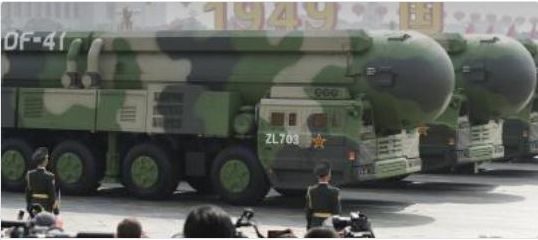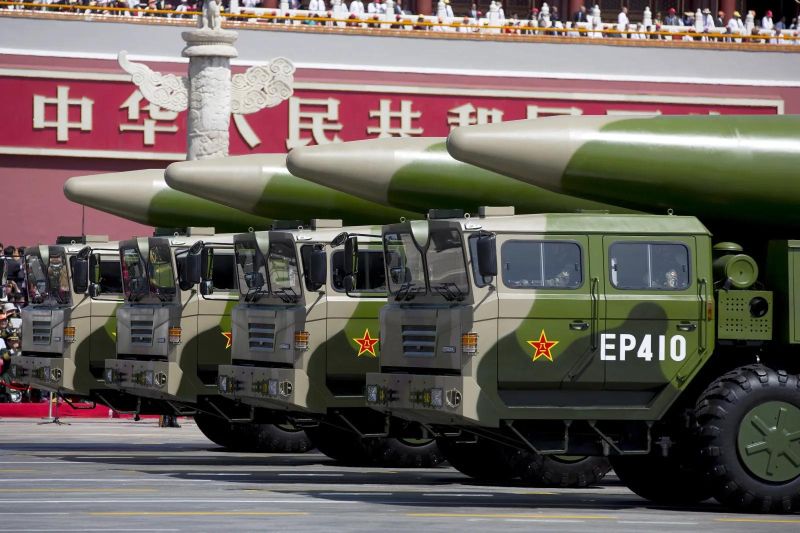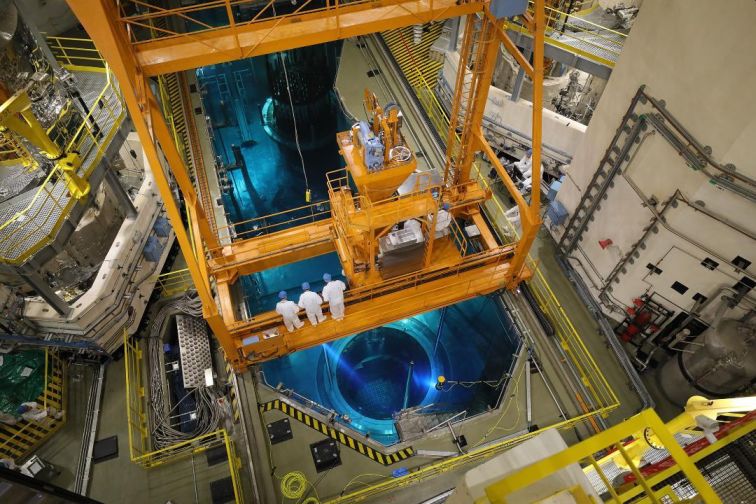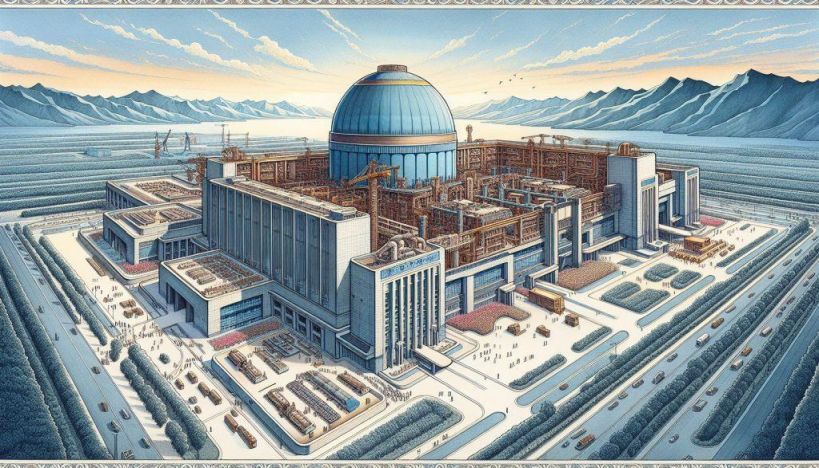By Eric Vandenbroeck and co-workers
Since 2018, American
defense analysts have repeatedly identified China as the greatest threat to U.S.
national security. They have variously described Beijing as a “systemic
challenge,” a “pacing threat,” and even a “peer adversary,” owing to China’s
massive military buildup, belligerent behavior in the Asia-Pacific, and global
campaign of economic coercion. These vague, buzzy phrases point to a growing
consensus: that China’s ambitions greatly imperil American national interests.
There is no consensus, however, on the intention behind China’s strategic
moves, chief among them its rapid buildup of nuclear weapons.
The U.S. defense
community has largely viewed this buildup in a narrow military framework
concerned with weapons capabilities and arms-race balance. China’s
nuclear arsenal 'might' not be a coercive tool to achieve well-defined military
objectives but possibly a symbol of national strength by which Beijing can earn
Washington’s respect as a major player in world affairs. However, any
understanding of this nuclear expansion must also account for Beijing’s
revisionist intentions.

China holds grand
ambitions to remake the world in its image. It intends to do so by first
dominating the western Pacific and then pulling much of Eurasia—a region that
stretches from China’s immediate neighborhood through Central Asia and
southeastern Europe—as well as Africa into its orbit. But Beijing has a
geographic predicament of which it’s acutely aware: a number
of states off its coastline that have signed on to U.S.-led coalitions
devoted to the regional status quo, and which are galvanized by China’s own
actions. If China escalates by launching a large-scale attack along its
maritime periphery, it risks a devastating and coordinated response that
jeopardizes its global designs.
The United States
should view China’s nuclear buildup as a tool that can help Beijing resolve its
continental isolation. China has initiated a short-of-war coercion campaign to
dissolve the U.S. alliance system in the Pacific, and its increasingly sophisticated
nuclear arsenal gives it more leverage to achieve this objective without
igniting a catastrophic great-power war. If Washington fails to address this
dimension of China’s nuclear breakout, it could risk its forward position in
the western Pacific, through which it defends a free, open, and prosperous
environment favorable to American interests.
Washington should be
alive to the danger. It must recognize the
geopolitical designs China has for its expanding nuclear arsenal and act to
preserve the regional balance. As Beijing’s coercion campaign threatens U.S.
allies, Washington must implement a countervailing strategy that arrays the United
States’ competitive advantages against China’s distinct vulnerabilities. China
may have already started wielding its nuclear power as an initial foray in its
larger worldmaking project, but the United States still has an opportunity to
nip these global ambitions in the bud.
Making Waves
Chinese President Xi
Jinping believes he is leading his country into a new era of Chinese-dominated
geopolitics. He believes a struggle between Chinese socialism and Western
democratic capitalism is already underway and cites his country’s growing
prosperity and influence as evidence that it is ready to supplant the United
States and remold the world. Such an international order would more closely
reflect China’s internal system than the liberal values that have shaped much
of the world for decades. Xi is particularly confident that
structural trends—as evidenced by the 2008 financial crisis and the rise of
populist movements in the West—favor China’s ascendancy.
But China’s geography
complicates Xi’s vision. Like Napoleonic France in the nineteenth century and
Germany, Japan, and the Soviet Union in the twentieth century, Beijing
considers itself hemmed in by hostile coastal states that are backed by a
global naval power. Also like its antecedents, China’s continental
position—straddling a type of land-sea boundary that the
twentieth-century Dutch American strategist Nicholas Spykman
dubbed the Eurasian “rimland”—raises the possibility that a poorly executed
Chinese strategy could ignite a cataclysmic war with the United States and its
Asian allies.
For Chinese
strategists, these past examples are instructive. The modern revisionists all
failed to resolve threats on their seaward flanks and suffered for it. Neither
France nor Germany was naturally inclined to the sea and were ruined at the
hands of rimland coalitions led by global naval powers. Imperial Japan provoked
a two-front war, fighting Chinese armies on the Asian mainland and American
expeditionary forces at sea, which proved too much to bear. And the
Soviet Union ultimately could not overcome its rimland Cold War opponent,
composed of coastal states and spearheaded by U.S. air and sea forces. Beijing
has thus determined that before it can pull a vast swath of Eurasia into its
orbit, it must first achieve primacy on its exposed maritime periphery.
Beijing protests that
its maritime flank is surrounded by two concentric, crescent-shaped island
chains littered with U.S. allies and military bases. The first, closer to
China, runs southward from Alaska’s Aleutian archipelago through Japan and
Taiwan and down past the Philippines. The second, farther east, runs from Japan
through the U.S. military hub on Guam and to the northern reaches of Australia.
The United States is bound by defense treaties to Australia, Japan, and the
Philippines, as well as to South Korea, which sits inside this rimland
perimeter.
This U.S.-backed
barrier has frustrated China since the early days of the Cold War, when a “hub
and spokes” network of bilateral alliances between the United States and a number of western Pacific states thwarted Beijing’s
regional ambitions. In the 1950s, the United States, in defense of its allies,
even threatened China with nuclear attack. In 1996, during the third Taiwan
Strait crisis, Washington humiliated Beijing when it dispatched two carrier
strike groups to support Taipei. Today, the United States is promoting
trilateral cooperation with Japan and South Korea to strengthen regional
defenses against ballistic missiles. As Xi watches this, the searing
experiences of the past are never far from his mind. And China now has in
spades something it once lacked: striking power, both nuclear and conventional,
of the kind that can split Washington from its Asia-Pacific allies.

Breaking Ground
The debate in the
United States over the meaning of China’s nuclear buildup has long played out
in narrow military terms, divorced from geopolitics. American analysts have
fixated primarily on whether Beijing is engaging in an arms race, whether it’s
countering what it perceives as an increased U.S. nuclear threat, or whether
its stated policy of “no first use” of nuclear weapons is genuine. But China’s
breakout can only be fully appreciated in the context of its geopolitical
ambitions. Focusing on how this expansion represents a means to its
broader political ends underscores why China has little interest in the
American understanding of “strategic stability,” or the idea that rivals will
not try to exploit military developments to their advantage. Put simply,
China’s nuclear geopolitics is about destabilizing the maritime barrier now set
up against it.
China’s nuclear
expansion will affect how U.S. allies perceive the regional military balance.
As they make their assessments, they are taking into account
the stunning nature, in both quantity and quality, of China’s nuclear breakout.
The United States has an active arsenal of some 3,700 nuclear warheads, though
less than half of these are deployed. Beijing is quickly closing the gap,
having increased its warhead inventory from about 200 to 500 between 2020 and
2023. The Pentagon has forecast that China will boast more than 1,000 warheads
by 2030 and upward of 1,500 by 2035. And China already has a formidable
capacity to employ such weapons in highly accurate strikes: it has more
land-based intercontinental and intermediate-range missile launchers than the
United States does. What’s more, Washington retired its only regional nuclear
option—a submarine-launched cruise missile—in 2013, meaning in a potential
crisis it would have no regionally based nuclear capability to reassure its
allies of its security guarantee.
The United States’
partners in the Asia-Pacific are understandably alarmed. According to a recent study
by the National Bureau of Asian Research, China’s quantitative advantages have
raised anxiety on the first island chain, particularly in Japan. Tokyo worries
that Washington will grow risk-averse along the rimland as China’s capacity to
conduct precision strikes against the continental United States continues to
increase, allowing Beijing to dial up the pressure without drawing an American
response.
China’s defense
establishment is also exhibiting an increasing interest in coercive nuclear
strategies. Chinese military theorists now routinely refer to the country’s
modernized nuclear weapons as a “trump card” that can impede external
intervention in regional affairs. And many Chinese defense analysts have
concluded that Russian President Vladimir Putin’s nuclear coercion in the course of Russia’s war in Ukraine has prevented NATO
from deeper intervention in that conflict, suggesting that Beijing could use
its arsenal to achieve similar ends.
The Chinese
conception of deterrence comprises the Western notion of dissuading adversaries
from taking a particular course of action, but it also includes a more
expansive goal: compelling adversaries to change their behavior. Training
manuals for the branch of the Chinese army that controls the country’s
land-based missiles have long advised that simply setting nuclear weapons at
higher levels of readiness will “create a great shock in the enemy psyche” and
shape the enemy’s actions. And now that China has a robust missile force to
conduct coercive nuclear attacks, such tactics will have more credibility in
the eyes of America’s regional partners. Beijing’s improved strike capabilities
could thus encourage it to publicly abandon its no-first-use nuclear policy to
drive a wedge between Washington and its allies.
As the United States’
Pacific partners increasingly see or experience Chinese efforts to use
nuclear-backed coercion, their view of the regional balance could shift. And
seeing inaction or insufficient action from Washington in the face of this
intimidation would give them justifiable cause for further alarm. Crafting an
effective response to China’s overall coercive power and the nuclear buildup
itself will be key to maintaining U.S. credibility in the region.
Simmering Point
China aims to use its
nuclear breakout to pierce the rimland barrier without igniting a great-power
war. Xi’s ability to dominate the conflict spectrum—from low-intensity
political pressure to potential nuclear warfare—has likely emboldened him to
sharpen the pressure in this region in recent months.
But China has been
honing its capacity to pursue this coercive campaign for well over a decade. In
2012, Beijing seized from the Philippines control of the Scarborough Shoal, an
important fishery in the South China Sea, using both low-intensity military force
and economic pressure, including boycotts of some Philippine exports. The
United States had protested China’s de facto annexation of the shoal, but
Beijing’s escalation against the Philippines forced Washington to back off.
Last summer, Beijing again initiated clashes in the South China Sea when
Chinese maritime vessels rammed into Philippine ships within Manila’s exclusive
economic zone. China faced no serious consequences.
Japan, too, has been
subject to Chinese coercion since the dawn of the twenty-first century—and the
pressure is rising with China’s nuclear buildup. Today, China is engaged in a
persistent effort to unilaterally change the status quo of the Japanese-administered
Senkaku Islands (known in China as the Diaoyu Islands) just
north of Taiwan; almost daily, the Chinese navy operates in their vicinity to
enforce China’s “domestic maritime law.” Chinese military forces also routinely
enter or surround Japanese territory. In August, for example, the Chinese navy
and air force violated Japan’s territorial waters and airspace—an escalation
that was eclipsed, just weeks later, when China sailed an aircraft carrier
through Japanese waters for the first time. This persistent pressure is
designed to wear Tokyo down, weaken the U.S.-Japanese alliance, and normalize
China’s behavior to create a new bar by which to measure future aggression.
Taiwan remains the
main target of China’s short-of-war coercion campaign. In addition to its
military and political intimidation of the island, Beijing attempts to
marginalize Taiwan’s standing on the world stage and erode its coverage within
international legal structures. But the threat of escalation is key to
subjugating Taiwan without large-scale warfare. Beijing can, for example,
exploit the possibility of an amphibious invasion to compel certain segments of
the Taiwanese political class and population to give in to Chinese control of
the island. Should Beijing decide to take this more extreme course of action,
it would likely use the threat of limited nuclear escalation to deter U.S. and
Japanese intervention.
Since Beijing
initiated its sprawling coercive campaign, few of the countries it has targeted
have grown their military capabilities. The Chinese army, on the other hand,
has transformed into Asia’s largest military force, in both conventional and
nuclear capability. For Xi, however, success is not about winning a
head-to-head military clash that provokes U.S. intervention. Instead, success
is defined as decoupling the United States from the region entirely by
undermining Washington’s credibility there and compelling U.S. allies to shy
away from confrontation. As China’s recent behavior suggests, China’s nuclear
buildup has emboldened Xi to accept greater risks to achieve these objectives.

Lifting the Countervail
Beijing’s
short-of-war coercion campaign has thrown Washington into a reactive, defensive
stance that has unnerved its regional partners. U.S. officials have yet to
address the regional strategic implications of China’s nuclear breakout. If
these trends continue, China could find itself well positioned to dissolve the
bonds that tie the United States to its Asia-Pacific allies.
To blunt China’s
momentum and regain the initiative, the United States needs a countervailing
strategy that can demonstrate credibility to its regional partners and change
Beijing’s calculus. China is simultaneously focused on its internal security,
its regional ambitions, and the larger global designs that its regional actions
support. Any U.S. strategy should force Xi to make punishing tradeoffs between
his goals so that he cannot harbor the illusion of advancing on one front
without jeopardizing the others.
China has distinct
vulnerabilities. Like all nations, it has finite resources and cannot simply
spend its way out of the burden of choice. This is especially true for an
emerging, relatively isolated continental power with grand ambitions, a slowing
economy, and the insecurity of a Marxist-Leninist regime—namely,
a deep, near-obsessive distrust of its own citizens. By contrast, the United
States is an established global power with a democratic system that lends
itself to far-flung alliances and the creative energies of free societies.
Washington’s task, then, is to exploit its favorable military, economic, and
political asymmetries to exacerbate Beijing’s continental isolation.
The military prong of
a countervailing strategy should emphasize existing U.S. advantages in alliance
partnerships, missile defense, and undersea warfare. By embedding Japan and
South Korea in a regional missile defense system and linking it to improved U.S.
homeland missile defenses, for example, Washington can alleviate its allies’
fears and raise the stakes for Beijing dialing up pressure on any of them.
Washington’s redeployment of a submarine-launched nuclear-armed cruise missile,
which would give it a prompt, regionally based response option, would further
boost allies’ confidence and divert more Chinese resources to missile defense
and undersea warfare.
The economic
dimension should make use of the allies’ interest in American markets. By
deepening trade relations in the western Pacific, Washington would convey to
its partners and Beijing that U.S. economic security is indivisible from
the regional status quo. Updated bilateral trade pacts focused on sectors that
China dominates—such as critical minerals and pharmaceutical supply
chains—would also wean Washington and its partners off the Chinese market and
harden them against Beijing’s coercion. Although American domestic politics has
made the establishment of trade pacts difficult, there is an appetite in
Washington for agreements that counter China’s strategy of creating economic dependencies.

The final prong of
the United States’ strategy should center on politics. Beijing has been waging
a largely one-sided philosophical struggle against the United States by
flooding online outlets with disinformation in an attempt to
exploit existing rifts within American society. Washington has hesitated to
meet this ideological challenge. But in doing so, it has forfeited the chance
to exploit China’s greatest vulnerability: its political system. Beijing
devotes enormous resources to controlling its 1.4 billion citizens. The United
States can use this fixation to impose steep costs on China, such as by finding
ways to circumvent online censorship and disseminate writing by Chinese
dissidents about the government’s corruption and economic failings. Beijing has
gone to great lengths to silence individual dissidents and stamp out minor
protests, suggesting it would spare no expense in countering a broader
campaign. The best way to establish guardrails with China is to steer Xi’s
attention away from his regional and global designs. The more he is focused at home, the less effort and fewer resources Beijing will
devote to power projection.
Without a
countervailing strategy that harnesses its competitive advantages, the United
States risks its forward position in the western Pacific, which will be further
eroded by a narrow military view of China’s nuclear breakout. Washington should
exploit its asymmetric strengths and focus on revitalizing its credibility
among its allies, exacerbating Beijing’s distinct vulnerabilities, and
ultimately tipping the cost-benefit balance for China’s nuclear-backed coercion
campaign. Once it appreciates the subtle role that China’s nuclear buildup
plays in advancing Beijing’s geopolitical agenda, the United States can shift
its policies to maintain the status quo.
For updates click hompage here